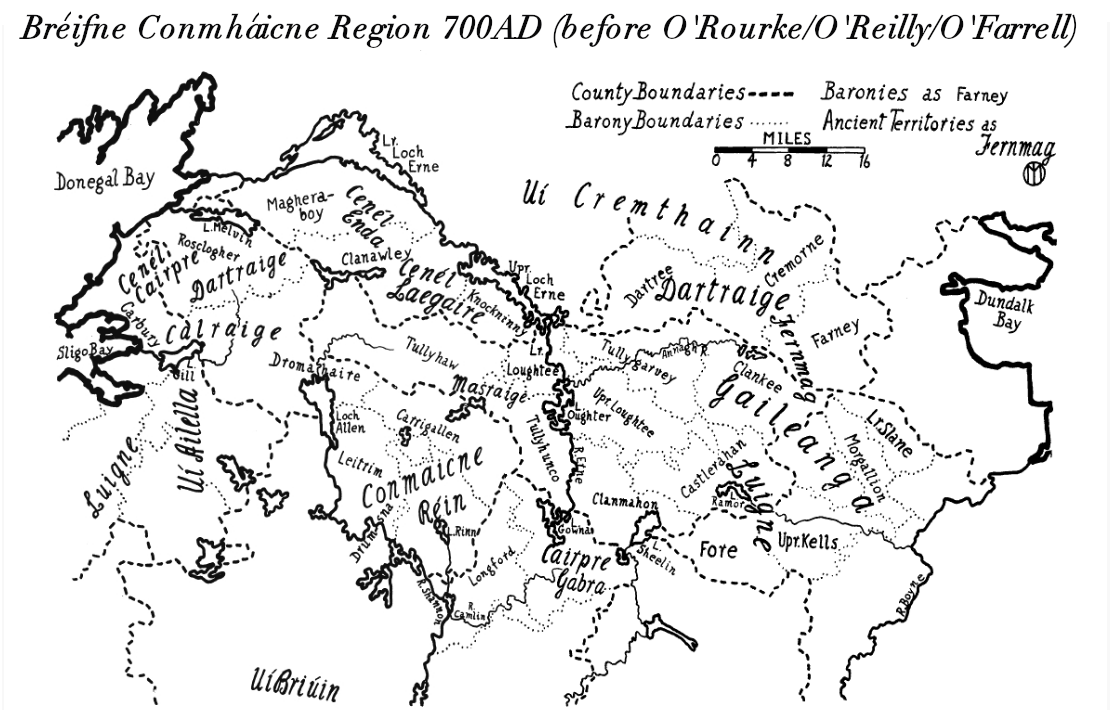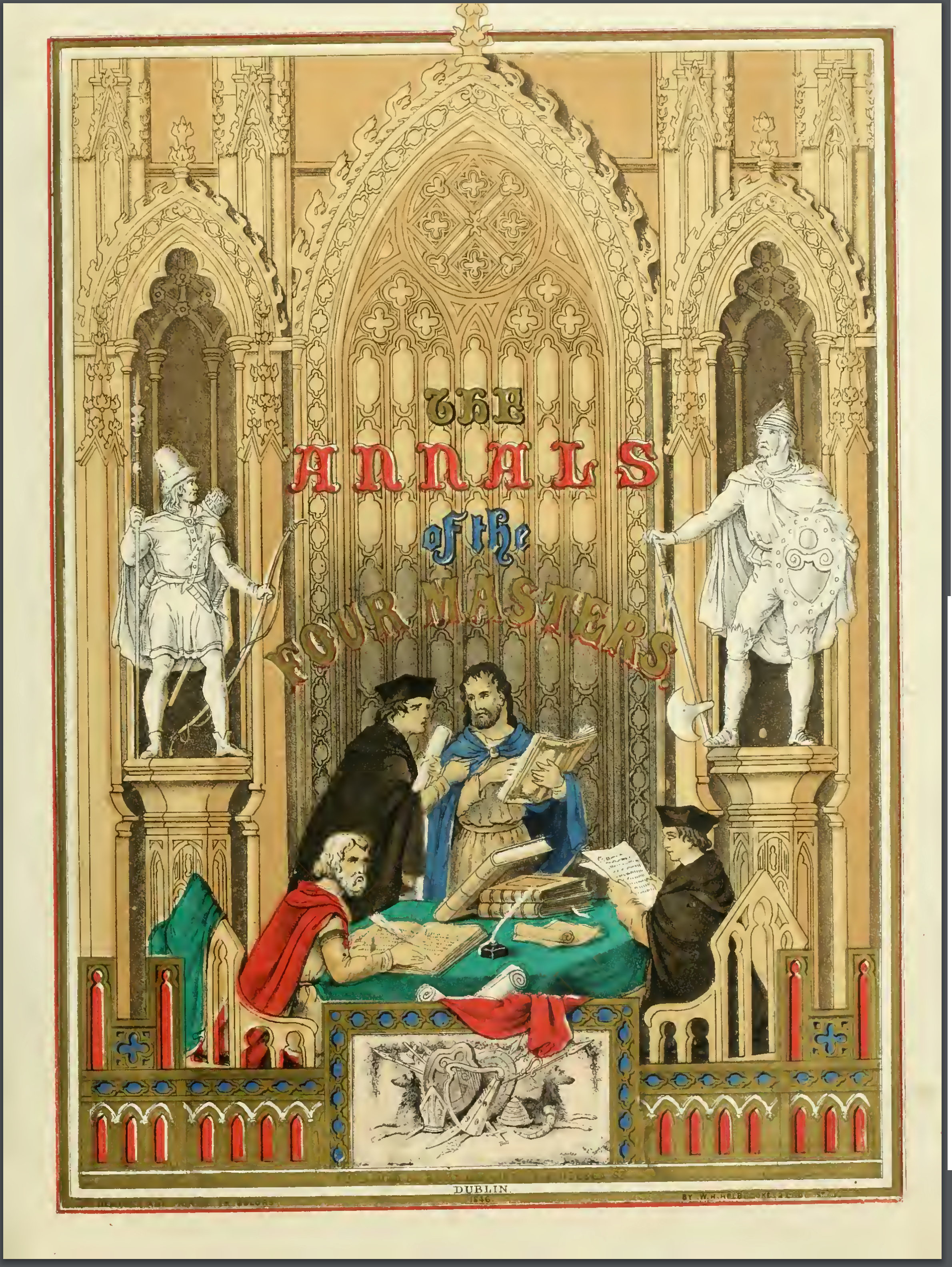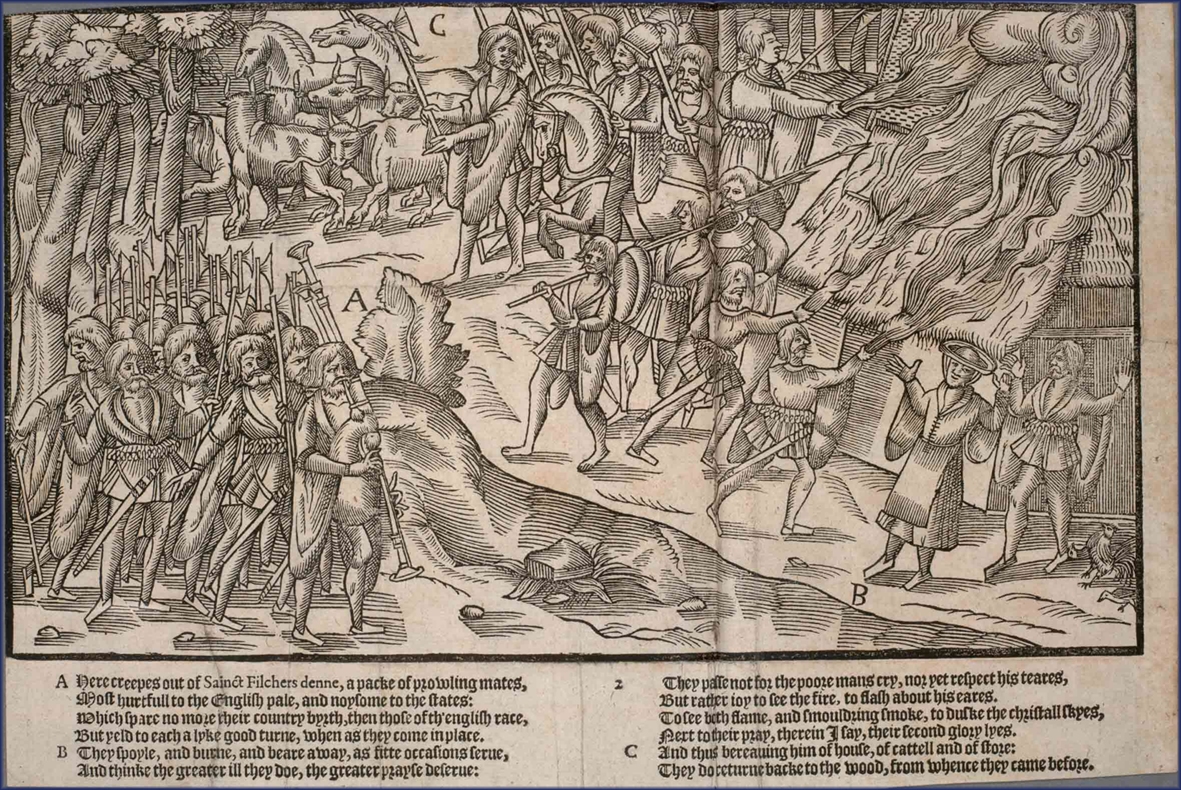|
Uaithne Mág Samhradháin
Uaithne Mág Samhradháin (anglicised Owny McGovern) was chief of the McGovern Clan and Baron or Lord of Tullyhaw barony, County Cavan from 1540 until his death. Ancestry His ancestry was Uaithne son of Maghnus (d. 1497) son of Tomás Óg (d. 1494) son of Tomás na Feasoige (d. 1458) son of Fearghal (d. 1393) son of Tomás (d. 1343) son of Brian ‘Breaghach’ Mág Samhradháin (d. 1298). He was a younger son and his older brother Tomás Mág Samhradháin, the Fourth was chief of the clan from 1512–1532. Career The Annals of the Four Masters for 1521 state- ''Donough, the son of Rory, son of Brian Maguire, was slain by the sons of Magauran, namely, Donnell Oge, son of Donnell Bearnagh, and Owny, the son of Manus Magauran. And there was not of his tribe in his time a better man than this Donough.'' The Annals of Ulster for 1521 state- ''Donchadh, son of Ruaidhri, son of Brian Mag Uidhir, was slain this year by the sons of Mag Samradhain, namely, by Uaithne, son of Maghnu ... [...More Info...] [...Related Items...] OR: [Wikipedia] [Google] [Baidu] |
McGovern
McGovern may refer to the following: * McGovern (name), surname of Irish origin * McGovern Institute for Brain Research People: * Alison McGovern (b. 1980), British Labour politician * Barry McGovern, Irish Actor * Bill McGovern (American football) (1962–2023), American football coach * Brian Magauran b.1592 was chief of the McGovern Clan of Tullyhaw, County Cavan from 1622 until his death. * Brian Mág Samhradháin (anglicised McGovern), chief of the McGovern Clan of Tullyhaw, County Cavan from c.1240 to 1258. * Brian 'Breaghach' Mág Samhradháin (anglicised McGovern), chief of the McGovern Clan of Tullyhaw, County Cavan from 1272 to 3 May 1294. * Brian Óg Mág Samhradháin (anglicised Brian McGovern Junior) d. 1584, was chief of the McGovern Clan of Tullyhaw, County Cavan until his death in 1584. * Brian McGovern (footballer), former Irish professional footballer * Colonel Bryan Magauran, the Sixth, (Gaelic- Brian Mág Samhradháin) was the last chief of the McGovern ... [...More Info...] [...Related Items...] OR: [Wikipedia] [Google] [Baidu] |
Baron
Baron is a rank of nobility or title of honour, often Hereditary title, hereditary, in various European countries, either current or historical. The female equivalent is baroness. Typically, the title denotes an aristocrat who ranks higher than a lord or knight, but lower than a viscount or count. Often, barons hold their fief – their lands and income – directly from the monarch. Barons are less often the vassals of other nobles. In many kingdoms, they were entitled to wear a smaller form of a crown called a ''coronet''. The term originates from the Late Latin, Latin term , via Old French. The use of the title ''baron'' came to England via the Norman Conquest of 1066, then the Normans brought the title to Scotland and Southern Italy. It later spread to Scandinavian and Slavic lands. Etymology The word '':wikt:baron, baron'' comes from the Old French , from a Late Latin "man; servant, soldier, mercenary" (so used in Salic law; Alemannic law has in the same sense). The sc ... [...More Info...] [...Related Items...] OR: [Wikipedia] [Google] [Baidu] |
Lord
Lord is an appellation for a person or deity who has authority, control, or power (social and political), power over others, acting as a master, chief, or ruler. The appellation can also denote certain persons who hold a title of the Peerage of the United Kingdom, peerage in the United Kingdom, or are entitled to courtesy titles. The collective "Lords" can refer to a group or body of Peerages in the United Kingdom, peers. Etymology According to the ''Oxford Dictionary of English'', the etymology of the word can be traced back to the Old English language, Old English word ''hlāford'' which originated from ''hlāfweard'' meaning "loaf-ward" or "bread-keeper", reflecting the Germanic tribes, Germanic tribal custom of a Germanic chieftain, chieftain providing food for his followers. The appellation "lord" is primarily applied to men, while for women the appellation "lady" is used. This is no longer universal: the Lord of Mann, a title previously held by Elizabeth II, the Queen o ... [...More Info...] [...Related Items...] OR: [Wikipedia] [Google] [Baidu] |
Tullyhaw
Tullyhaw (, which means 'the Territory of Eochaidh', an ancestor of the McGoverns, who lived ) is a Barony in County Cavan in Ireland. The area has been in constant occupation since pre-4000 BC. Located in the northwest of the county, it has been referred to as Cavan's panhandle. Tullyhaw was originally a ''túath'' within West Bréifne. It was later absorbed into East Bréifne in the sixteenth century. Glangevlin.com: History - The Kingdom Of The McGoverns. https://www.glangevlin.com/2021/05/13/the-kingdom-of-the-mcgoverns/ In 1579, East Bréifne, then part of Connacht, was made a shire. The shire was named County Cavan, being named after Cavan (), the area's main town. The administration remained in the control of the local Irish dynasty and subject to the Brehon and Canon Law. In 1584, Sir John Perrot formed the shire into a county in Ulster. It was subdivided into seven baronies: *two of which were assigned to Sir John O'Reilly and *three to other members of th ... [...More Info...] [...Related Items...] OR: [Wikipedia] [Google] [Baidu] |
County Cavan
County Cavan ( ; ) is a Counties of Ireland, county in Republic of Ireland, Ireland. It is in the Provinces of Ireland, province of Ulster and is part of the Northern and Western Region. It is named after the town of Cavan and is based on the historic Gaelic Ireland, Gaelic territory of East Breifne, East Breffny (''Bréifne''). Cavan County Council is the Local government in the Republic of Ireland, local authority for the county, which had a population of 81,704 at the 2022 census. Geography Cavan borders six counties: County Leitrim, Leitrim to the west, County Fermanagh, Fermanagh to the north, County Monaghan, Monaghan to the north-east, County Meath, Meath to the south-east, County Longford, Longford to the south-west and County Westmeath, Westmeath to the south. Cavan shares a border with County Fermanagh in Northern Ireland. Cavan is the 19th largest of the 32 counties in area and the 25th largest by population. The county is part of the Northern and Western Region, a ... [...More Info...] [...Related Items...] OR: [Wikipedia] [Google] [Baidu] |
Brian ‘Breaghach’ Mág Samhradháin
Brian (sometimes spelled Bryan in English) is a male given name of Irish and Breton origin, as well as a surname of Occitan origin. It is common in the English-speaking world. It is possible that the name is derived from an Old Celtic word meaning "high" or "noble". For example, the element ''bre'' means "hill"; which could be transferred to mean "eminence" or "exalted one". The name is quite popular in Ireland, on account of Brian Boru, a 10th-century High King of Ireland. The name was also quite popular in East Anglia during the Middle Ages. This is because the name was introduced to England by Bretons following the Norman Conquest. Bretons also settled in Ireland along with the Normans in the 12th century, and 'their' name was mingled with the 'Irish' version. Also, in the north-west of England, the 'Irish' name was introduced by Scandinavian settlers from Ireland. Within the Gaelic-speaking areas of Scotland, the name was at first only used by professional families of Irish ... [...More Info...] [...Related Items...] OR: [Wikipedia] [Google] [Baidu] |
Tomás Mág Samhradháin, The Fourth
{{disambiguation ...
Tomás may refer to: * Tomás (given name) * Tomás (surname) Tomás is a Spanish, Portuguese, or Irish surname, equivalent of '' Thomas''. It may refer to: * Antonio Tomás (born 1985), professional Spanish footballer * Belarmino Tomás (1892–1950), Asturian trade unionist and socialist politician * ... [...More Info...] [...Related Items...] OR: [Wikipedia] [Google] [Baidu] |
Annals Of The Four Masters
The ''Annals of the Kingdom of Ireland'' () or the ''Annals of the Four Masters'' () are chronicles of Middle Ages, medieval Irish history. The entries span from the Genesis flood narrative, Deluge, dated as 2,242 Anno Mundi, years after creation to AD 1616. Publication delay Due to the criticisms by 17th-century Irish historian Tuileagna Ó Maol Chonaire, the text was not published in the lifetimes of any of the participants. Text The annals are mainly a compilation of earlier annals, although there is some original work. They were compiled between 1632 and 1636, allegedly in a cottage beside the ruins of Donegal Abbey, just outside Donegal (town), Donegal Town. At this time, however, the Franciscans had a house of refuge by the River Drowes in County Leitrim, just outside Ballyshannon, and it was here, according to others, that the ''Annals'' were compiled. [...More Info...] [...Related Items...] OR: [Wikipedia] [Google] [Baidu] |
Annals Of Ulster
The ''Annals of Ulster'' () are annals of History of Ireland, medieval Ireland. The entries span the years from 431 AD to 1540 AD. The entries up to 1489 AD were compiled in the late 15th century by the scribe Ruaidhrí Ó Luinín, under his patron Cathal Óg Mac Maghnusa, on the island of ''Senadh-Mic-Maghnusa'', also known as ''Senad'' or Ballymacmanus Island (now known as Belle Isle, where Belle Isle Castle is located), near Lisbellaw, on Lough Erne in the kingdom of ''Fir Manach'' (Fermanagh). Later entries (up to AD 1540) were added by others. Entries up to the mid-6th century are retrospective, drawing on earlier annalistic and historical texts, while later entries were contemporary, based on recollection and oral history. Thomas Charles-Edwards, T. M. Charles-Edwards has claimed that the main source for its records of the first millennium A.D. is a now-lost Armagh continuation of the ''Chronicle of Ireland''. The Annals used the Irish language, with some ... [...More Info...] [...Related Items...] OR: [Wikipedia] [Google] [Baidu] |
Ballymagauran
Ballymagauran (), historically known in English as Ballymagowran and also sometimes spelled Ballymacgovern or Ballymagovern, is a hamlet and townland in the west of County Cavan in Ireland. Townlands.ie: Ballymagauran Townland, Co. Cavan. https://www.townlands.ie/cavan/tullyhaw/templeport/ballymagauran/ballymagauran/ It lies on the border with County Leitrim, lying within both the civil parish of Templeport and the historical barony of Tullyhaw. Townlands.ie: Barony of Tullyhaw, Co. Cavan. https://www.townlands.ie/cavan/tullyhaw/ Ballymagauran is located at the southern end of the barony of Tullyhaw on the R205 road between Ballinamore and Ballyconnell. History Medieval In medieval times, the ''Mac Shamhráin'' (anglicised as McGovern or Magauran) ''túath'' of ''Teallach Eachdhach'' (Tullyhaw), then part of West Bréifne in Connacht, was divided into economic taxation areas called ballibetoes, from the Irish ''Baile Biataigh'' (anglicised as 'Ballybetagh'), meaning 'A Pro ... [...More Info...] [...Related Items...] OR: [Wikipedia] [Google] [Baidu] |
Kern (soldier)
A kern was a Gaelic warrior, specifically a light infantryman, in Ireland in the Middle Ages. Etymology The word ''kern'' is an anglicisation of the Middle Irish word ''ceithern'' or ''ceithrenn'' meaning a collection of persons, particularly fighting men. An individual member is a ''ceithernach''. The word may derive from a conjectural proto-Celtic word *''ketern''ā, ultimately from an Indo-European root meaning a chain. Kern was adopted into English as a term for a Gaelic soldier in medieval Ireland and as '' cateran'', meaning 'Highland marauder', 'bandit'. The term ''ceithernach'' is also used in modern Irish for a chess pawn. Military roles Kerns notably accompanied bands of the mercenary gallowglasses as their light infantry forces, where the gallowglass filled the need for heavy infantry. This two-tier "army" structure though should not be taken to reflect earlier Irish armies prior to the Norman invasions, as there were more locally trained soldiers filling va ... [...More Info...] [...Related Items...] OR: [Wikipedia] [Google] [Baidu] |
Brian Óg Mág Samhradháin
Brian Óg Mág Samhradháin, the Third, (anglicised Brian McGovern Junior) d. 1584, was chief of the McGovern Clan and Baron or Lord of Tullyhaw barony, County Cavan until his death in 1584. Ancestry His ancestry was Brian Óg son of Brian son of Tomás (died 1532) son of Maghnus (died 1497) son of Tomás Óg (died 1494) son of Tomás na Feasoige (died 1458) son of Fearghal (died 1393) son of Tomás (died 1343) son of Brian ‘Breaghach’ Mág Samhradháin (died 1298).M.V. Duignan (1934), "The Ui Briúin Bréifni genealogies", pp. 90–137, in JRSAI Vol. LXIV He was the eldest son and had two brothers who both later succeeded him as chiefs of the clan, Tomas Óg Mág Samhradháin and Feidhlimidh Mág Samhradháin, together with a third brother Emonn of Lissanover. Chieftainship On the death of the McGovern chief, Brian Óg took the chieftaincy and moved to the chief's residence in Ballymagauran. Death The Annals of Loch Cé for 1584 state- ''Mac Samhradhain, i.e., Brian ... [...More Info...] [...Related Items...] OR: [Wikipedia] [Google] [Baidu] |




